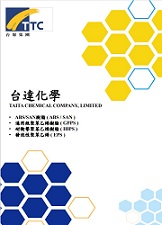| TAITACELL® EPS Resin |

Catalog |
The Characteristics and applications of TAITACELL® EPS Resin
TAITACELL® EPS Resin can be classified by its bead size: MM、T、S、Ss and F
|
| Item |
Download |
| SDS (Safety Data Sheet) |
EPS |

|
| FR-EPS |

|
| FR-EPS (Non-HBCD) |

|
| ISO Certificate |
ISO-9001 |

|
| ISO-14001 |

|
| ISO-45001 |

|
| ISO-50001 |

|
| RoHS (Restriction of Hazardous Substances Directive) |
Please contact your Sales Rep |
| FDA (U.S. Food and Drug Administration) |
EPS |

|
| Typical |
Grade |
Characteristics |
Applications |
| General Purpose Grade |
301

301MM
301T
301S
301Ss
301F |
Can be processed over a wide range of molding conditions. Good strength. Low production cost. Low steam consumption. Suitable for block case molding. |
Block Molding, Fish, Fruit and Vegetable Boxes |
| Fast-Molding Grade |
391

391MM
391T
391S
391Ss
391F |
Short cycle time. Short condition time. Physical properties similar to EPS-301. |
Packaging for Electronics and Household Electrical |
| Flame Retardant Grade |
321

321MM
321T
321S
321Ss
321F |
Pass 94HF-1 test, self-extinguishing. Other physical properties similar to EPS-301. |
Construction Materials |
| Non HBCD Flame Retardant Grade |
321N

321NMM
321NT
321NS
321NSs
321NF |
Pass SGS test, not contain HBCD self-extinguishing. Other physical properties similar to EPS-321. |
Construction Materials |
| Anti-Static Grade |
351

351SA
351SAA
351FA
351FAA |
Good anti-static effect for products. Physical properties similar to EPS-301. |
Anti-Static Packaging for Electronics and Electrical Appliances |
The Physical Properties of TAITACELL® EPS resin--
| Grades |
Properties |
Unit |
MM |
T |
S |
Ss |
F |
EPS-301
EPS-391
EPS-321
EPS-321N
EPS-351 |
Bead Size Range |
mm |
1.2-1.8 |
1.0-1.4 |
0.8-1.1 |
0.65-0.9 |
0.45-0.75 |
| Expandability (time) |
EPS-301 |
80-95 |
70-85 |
65-80 |
65-80 |
55-70 |
| EPS-391 |
70-85 |
65-80 |
60-75 |
60-75 |
50-65 |
| EPS-321 |
80-95 |
70-85 |
65-80 |
65-80 |
55-70 |
| EPS-321N |
80-95 |
70-85 |
65-80 |
65-80 |
55-70 |
| EPS-351 |
--- |
--- |
65-80 |
--- |
55-70 |
| Water content (max) |
% |
0.5 |
0.5 |
0.5 |
0.5 |
0.5 |
The information contained herein is, to our best knowledge, true and accurate. However, since conditions of use are beyond our control,
all recommendations or suggests are presented without guarantee or responsibility on our part. We disclaim all liability in connection with the use of information contained herein or otherwise.
All risks of such use are assumed by the user. Furthermore, nothing contained herein shall be constructed as an inducement or recommendation to use any process or to manufacture or use any product in conflict with existing or future patents.
Processing Procedure The standard procedure of processing TAITACELL
® EPS Resin beads into expanded blocks or molded articles include three stages: Prefoaming, Conditioning and Molding.
- Prefoaming:
The beads are heated by hot water, hot air, steam or infrared heating in a batch or continuous operation. The beads are, thus expanded to about 50~90 times their original volume and the density is reduced to as little as 15Kg/m3. Bulk density of prefoamed beads varies with the equipment, temperature and time. Therefore a trial run is necessary to determine the optimum operation conditions. The final density of the finished blocks or moldings will be the same as the bulk density of prefoamed beads.
- Conditioning:
The prefoamed beads are conditioned at room temperature in a ventilated area which allows beads to dry and aerate. The conditioning generally requires 24 hours and is essential to the quality of the molded products. However, when using fast molding EPS, the condition time should not exceed 16 hours.
- Molding:
A perforated mold is filled with conditioned perfoamed beads and low pressure steam is admitted through the small holes of the mold. This steam sweeps away the air in the interstices between beads. After a short time the steam pressure is increased to about 0.5~1.0kg/cm2 causing the perfoamed beads to fuse in the mold. The mold is then water or air cooled to allow the removal of the molded article.